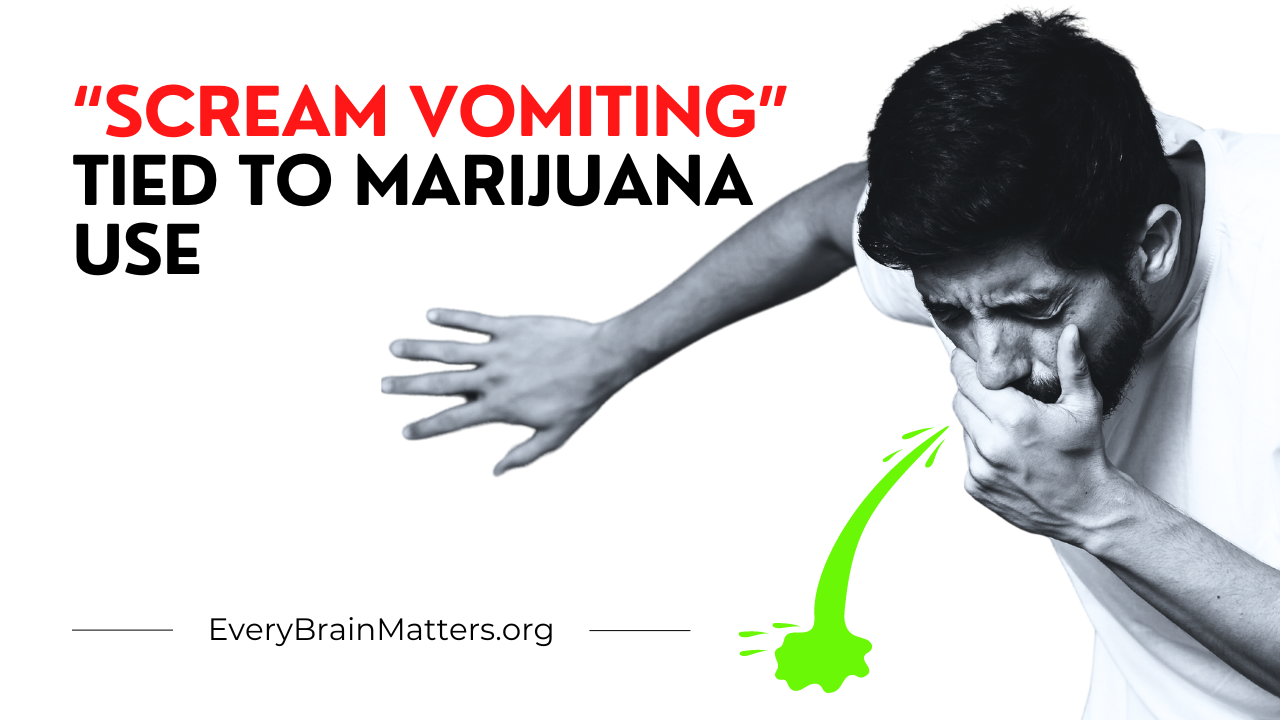Posted on January 17, 2024 View all news
“After about 30 minutes, the EMT came out and told me my son was gone. Brian’s father arrived a short time later, and I had to tell him that our son was dead…The official cause of death was dehydration due to cannabinoid hyperemesis syndrome.”
~ Regina Denny, a mother who lost her 17-year-old son to CHS
One of the “benefits” of cannabis is supposed to be the suppression of nausea and increased appetite. But popping a potent edible or puffing from a vape can result in the OPPOSITE.
“A growing number of industrialized-grade marijuana consumers are reaching toxic levels harder and faster, which teens are calling greening out. Some are even being diagnosed with Cannabinoid Hyperemesis Syndrome, an excruciating condition that leaves many people literally screaming in agony.
What is Cannabinoid Hyperemesis Syndrome?
“They are writhing, holding their stomach, complaining of really bad abdominal pain and nausea. They vomit and then just continue to vomit whatever they have in their stomach, which can go on for hours.”
~ Dr. Sam Wang, MD, Associate Professor of Pediatrics, Children’s Hospital Colorado
Cannabinoid Hyperemesis Syndrome, more commonly known as CHS, is an illness tied to cannabis use. It affects users of all ages, genders, and backgrounds. The typical victim has consumed marijuana multiple times a day for at least two years.
CHS can present for the first time without warning, and thereafter, the user risks becoming violently and painfully ill every time they use marijuana.
And this means any marijuana at all.
Switching to edibles or concentrates, vaping instead of smoking, changing strains, opting for “pesticide-free” products, and even choosing products that only contain CBD instead of THC – none of that makes a difference.
Symptoms of CHS
“These folks are really suffering. They can get pretty sick. They vomit like crazy and make frequent emergency department visits because they just can’t stop vomiting.”
~ Dr. Eric Lavonas, MD, Denver Health Medical Center
Mild/Prodromal Phase
This phase can last for months or even years.
- Increased thirst
- Sweating
- Mild discomfort
- Anxiety
Acute/Hyperemetic Phase
On average, this phase lasts 2 to 3 days and may last up to a week. It reoccurs continually at irregular intervals every few weeks or months as long as the person continues to use marijuana.
- Severe recurrent nausea
- Retching
- Cyclical vomiting – up to 12 times an hour
- Cramping abdominal pains
The nausea is painful enough to cause some sufferers to “scromit” – scream AND vomit. They may develop a fear of eating and experience drastic weight loss.
Chalfonte LeNee Queen, a San Diego resident who endured repeated undiagnosed CHS episodes for 17 agonizing years, told NPR, “I’ve screamed out for death. I’ve cried out for my mom, who’s been dead 20 years, mentally not realizing she can’t come to me.” At one point, the five-nine Queen only weighed just 109 pounds.
Left untreated, CHS can result in dehydration, electrolyte imbalance, kidney failure, and even death.
Difficult to Diagnose
“They’ll often present to the emergency department three, four, five different times before we can sort this out.”
~ Dr. Kennon Heard, MD, an Emergency Room physician in Aurora, Colorado
The symptoms of acute CHS can be so severe as to require an emergency room visit, where it is often initially mistaken for other illnesses – food poisoning, stomach flu, pancreatitis, hepatitis, heart attack, ectopic pregnancy, and several other serious medical conditions. The most common misdiagnosis is cyclic vomiting syndrome.
The problem with these misdiagnoses is that the medications that are typically given for nausea and vomiting are utterly ineffective against CHS. Because CHS is so little known, some doctors will prescribe the wrong antidote – including medical marijuana – which makes the condition much, much worse.
The primary way to differentiate between CHS and other similar medical conditions is by establishing that (1) the patient has a history of cannabis use, (2) severe nausea and vomiting that is hard to control, and (3) the symptoms cease after use is discontinued.
When patients try to deny or hide their marijuana use, they put themselves at risk of unnecessary, invasive, and potentially dangerous diagnostic procedures such as exploratory surgery.
Dr. Heard’s estimate is overly optimistic. One study found that the average CHS patient goes to the ER seven times and receives three misdiagnoses before correctly identifying their condition.
Treating Cannabinoid Hyperemesis Syndrome
“The only proven therapy is cessation…That’s the only thing published in the literature that’s proven to stop it.”
~ Dr. Lee Cantrell, Director, California Poison Control System, San Diego Division
Oddly enough, one thing that may temporarily lessen the pain, nausea, and vomiting is long, scalding hot baths or showers.
One thought is that marijuana disrupts a receptor within the brain that regulates temperature, and the hot temperature “resets” it. An alternate theory is that hot water draws blood away from the gastrointestinal tract, providing temporary relief.
But stopping marijuana use is the only permanent solution. This can be a challenge since patients with CHS almost universally suffer from cannabis use disorder, too.
Patients who quit using do recover, typically within a few weeks.
However, if they start using marijuana again, they will very soon experience a CHS relapse.
How Big is the Problem?
“CHS is certainly not very rare. We see it absolutely every week in our ER.”
~ Dr. Andrew Monte, MD, PhD, UCHealth University of Colorado Hospital
In states where the drug is legal, CHS is emerging as one of the most prevalent medical issues among people making marijuana-related trips to the ER.
One study published in 2018 in Basic & Clinical Pharmacology and Toxicology suggests that one-third of patients in an urban Emergency Department reported CHS symptoms with heavy marijuana use.
Dr. Joseph Habboushe, MD, with the Weill Cornell Medicine Department of Emergency Medicine, says, “This isn’t surprising, and we’re certainly going to see more of this.”
Potent Pot is a Problem
“In the 1990s most typical ‘joints’ contained 1–3 mg of THC. Today, plants are being raised and modified to produce a higher concentration of THC. … The typical joint in Colorado [now] contains 18 mg of THC or more. Currently, in the ED, we see patients who self-report smoking 2,000 mg or more of THC in a day.”
“In the 1990s most typical “joints” contained 1–3 mg of THC. Today, plants are being raised and modified to produce a higher concentration of THC…Previously, people would smoke 1–3 mg of THC. The typical joint in Colorado contains 18 mg of THC or more. Currently, in the ED, we see patients who self-report smoking 2,000 mg or more of THC in a day.”
~ Dr. Karen Randall, DO, Emergent Medical Illnesses Related to Cannabis Use
Many people believe that marijuana is entirely safe, especially those who occasionally smoked it when they were younger and who did not suffer any severe consequences. But the pot of the past simply does not compare to the strong strains of today.
Although/ the exact mechanism behind CHS remains unknown, the evidence does support both a dose-dependent relationship and a buildup of cannabis toxins over time. The long-term frequent and heavy use of high-THC marijuana is currently the one factor common to all patients diagnosed with CHS.
The Bottom Line
“Legalizing pot seems like a common sense policy, but in fact, it’s a public health disaster that the MJ industry is doing its darndest to cover up. Totally unwoke, I know, but facts are facts.”
~ Eve Simmons, reporter for the Daily Mail
Thanks to legalization, CHS cases are on the rise. Dr. Heard co-authored a 2009 study that showed in states where medical or recreational marijuana is legal, the number of CHS diagnoses nearly doubled.
A disturbing number of those put at risk are children and young adults.
Specifically looking at Colorado as an example, Dr. Wang published an analysis in the September 2021 edition of JAMA Open Network that found between 2013 and 2018, there were more than 800,000 cases of uncontrollable vomiting reported in the state, and over 500,000 of these patients had government/public insurance. Meaning this is costing taxpayers.
Three points are glaringly evident.
First, that is a 29% increase since legislation.
Second, over a third of those patients were 25 years old or younger.
Third, hundreds of thousands of cases is not a coincidence.
That is just one state and one brief period of time. If marijuana legalization continues to expand, the number of annual CHS cases will likewise continue to increase.
As Dr. Heard says, “It is certainly something that, before legalization, we almost never saw. Now, we are seeing it quite frequently.”
******
Every Brain Matters is a trusted educational resource for individuals and families wanting to stay safe from the harms of marijuana use and the expanding drug culture.
We reject the false narrative that marijuana is a harmless expression of personal freedom. Based on the latest scientific evidence and personal stories, our position is that marijuana is a dangerous and addictive drug, and like all drugs of abuse, it destroys lives.
You can help spread awareness by sharing this article. To stay informed, join our movement and subscribe to our channel. If you found this information worthwhile, please consider making a tax-deductible donation to Every Brain Matters.

